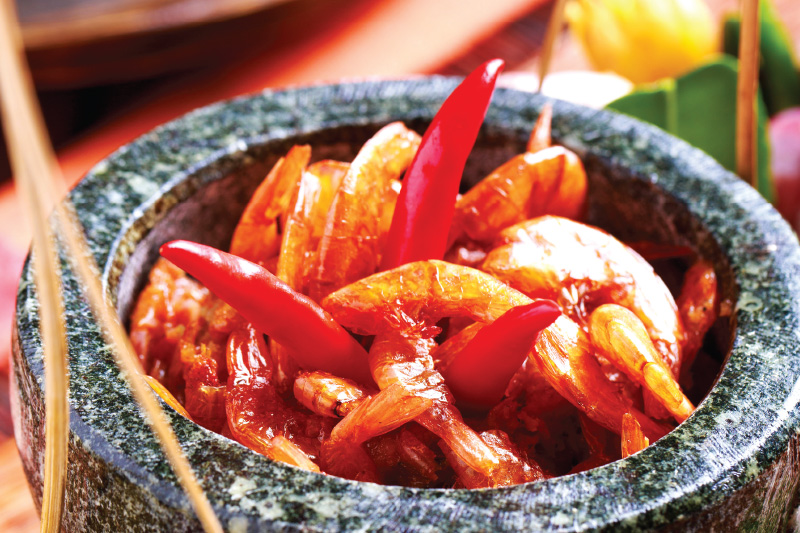
Following the Trail of Flavours in the South
Your guide to the myriad tastes and textures of Thailand’s culinary melting pot.
Words & Photos: Sirin P. Wongpanit
Flanked by two coastlines, the long and narrow stretch of land Thais refer to as the “axe handle of Siam” is otherwise known as the South of Thailand, where foodies savour fresh, albeit deliciously strong and pungent flavours.
Summarizing a cuisine so vast and complex as southern Thailand’s is not an easy task, but it can be managed with a touch of imagination, a collection of memories and Google Maps.
Let’s start with the map. Officially, the South of Thailand starts as soon as you enter the province of Chumphon after passing through Prachuap Khiri Khan. From here, the southern part of the country stretches all the way to Yala’s Betong district. This region covers 14 provinces, spread over 70,000 square kilometres. Driving from Bangkok to the southernmost tip of Yala, barring traffic jams, takes about 15 hours and covers about 1,200 kilometres of road.
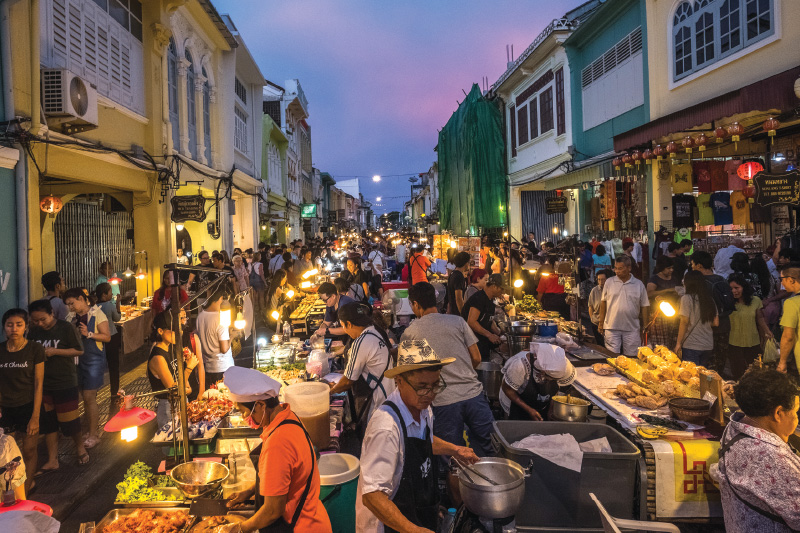
Getting the bearings right is important for me, while maps fire my imagination and get me wondering what people do in these places. What is the culture, the traditions – and what’s for lunch?
Southern Thailand is a rich melting pot. People from around the world arrived here long before the mining heyday of King Rama V’s reign. Merchants and seafarers from around the globe came to trade, settle, and infuse the local cuisine with their own flavours. This is how the repertoire of southern cuisine that we have come to know and love was created.
Chillies, pungent ingredients and strong herbs are what comes to mind when I reflect on my own journey through southern cuisine. Fiery curries that are consumed all day, even at breakfast, dominate the scene. The fish cakes, the fried chicken, the ultra-spicy, sour curries (think gaeng som) are just some of the classics southern folk use to measure a cook’s ability. Then comes the long list of “fresh desserts” that Phuket people eat for breakfast along with a hearty plate of savoury delights.
While outsiders might identify southern cuisine as a single collection of dishes, the natives are far more discerning.
“Even the same curries taste different from one province to the next,” says Amnat Chotchuang, a Koh Samui native and owner of Sabienglae Restaurant in Lamai, Samui. “And the two coastlines, one along the Gulf of Thailand and the other on the Andaman Sea, also make a big difference. Fish and seafood from the Gulf, with its calmer waters, are smaller, sweeter, and more tender in taste and texture compared with those from the other side. And native ingredients, such as shrimp pastes from various locations, taste different. That’s how locals can always identify tastes from home.”
Geography and climate also play a subtle role in flavouring southern dishes.
“Whether we realise it or not, what we put in our mouths is commanded by the body,” explains Dr. Niphatchanok Najpinij, a lecturer in gastronomy at Suan Dusit University in Bangkok. “Eating spicy dishes for breakfast might seem crazy to most people, but for southern folk living in a hot and humid climate, the spicy food helps eliminate bodily sluggishness. Through sweat, the body cools off. Hence, eating spicy food in the South is a natural thing to do.”
The local way of life has also given birth to unique eating habits. For instance, during family fishing trips, children in Samui learn how to use a small spear to extract flesh from molluscs.
“We ate sea urchin and small oysters fresh and raw while growing up,” recalls Amnat. “They sustained us during low tide. We would hang out on the shore, setting up a beachside kitchen to make a quick, spicy salad out of those molluscs and eat them with our packed rice. We called it ‘kin hor’, or packed lunch.”
Hop across to the Andaman side to find Phuket’s delicious Peranakan cuisine, whose flavours and stories saw the Pearl of the Andaman Sea named a UNESCO Creative City of Gastronomy in 2015.
That global recognition has encouraged the island’s younger generation to pay more attention to their unique roots. The Peranakan cuisine in Phuket is enjoying a revival as old specialities make their way back onto menus across the island. The rich stories behind these classics make the food even more delicious.
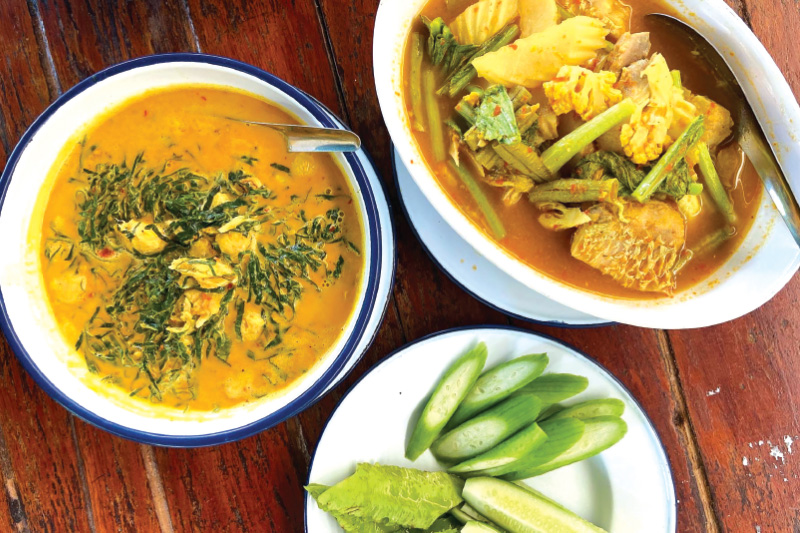
A Typical Day Eating in the South
Breakfast
- Khanom cheen or curried noodles with all the trimmings, plus fried chicken, steamed fish cake, or “hor mok” (steamed fish souffle)
- Hit the local markets for more breakfast options. If you’re in Phuket, try the “fresh sweets” or “khanom sod”, and pa thong go (fried dough) with kaya or coconut custard. For something heartier, go for the fresh fried roti or mataba.
- In Phuket, Trang and Hat Yai, dim sum is also a popular choice for breakfast.
Lunch
- In Samui, try out their spicy salad made with fresh sea urchin (hoy men) and oyster (hoy jor). Another unique dish is “muk sai or wai tom kathi” or baby squid with long, slender tentacles cooked in coconut milk. Another must-try is the “moo khua khoey”, or pork belly toasted with shrimp paste and local herbs.
- When in Phuket, treat yourself to a Peranakan feast. Popular choices are “moo hong” (pork stew) and “gaeng tu mee” or fish curry with okra. You can also try Hokkien noodles, “loba” or stewed pork entrails and local spring rolls.
Dinner
- Visit the coast anywhere in Thailand and you are bound to find seafood galore. Fresh is always the best. In Chumphon local fisher folk set up shop on the shore selling the freshest grilled squid I have ever eaten. In Phuket, hit Rawai Beach for freshly cooked seafood at any of the casual seaside eateries.
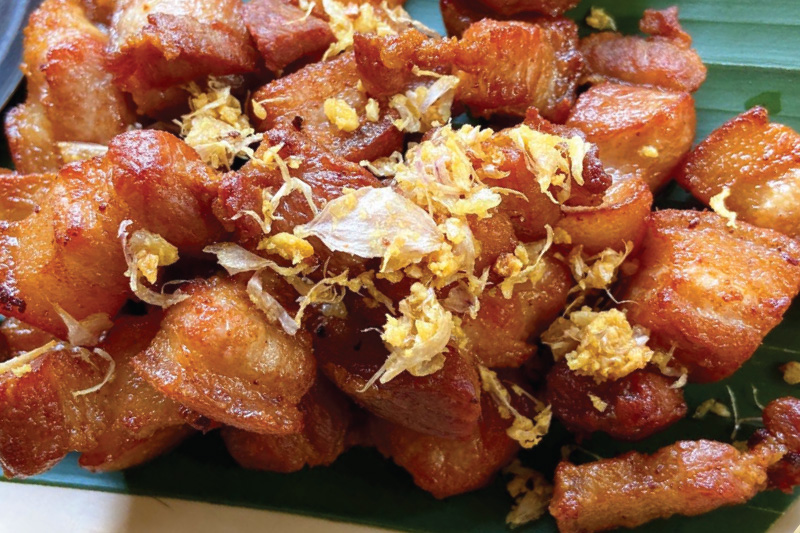
พื้นที่ภาคใต้ของประเทศไทยได้รับการขนานนามว่า “ด้ามขวานแห่งสยาม” ด้วยลักษณะทางภูมิศาสตร์ที่ขนาบด้วยชายฝั่งทั้งสองด้านและผืนแผ่นดินที่ทอดตัวยาวจากเหนือจรดใต้ ลักษณะเฉพาะตัวดังกล่าวนำไปสู่วัฒนธรรมอาหารที่นิยมรสชาติจัดจ้านร้อนแรงที่ทำให้ผู้ลิ้มลองไม่สามารถหักห้ามใจจากความอร่อยนี้ได้
ไม่ใช่เรื่องง่ายที่จะหาคำจำกัดความให้กับศิลปะการทำอาหารพื้นเมืองภาคใต้ แต่ด้วยจินตนาการ ความทรงจำที่สั่งสม และความช่วยเหลือเล็กๆ น้อยๆ จากกูเกิ้ลแม็พ นิยามเหล่านั้นก็ปรากฏได้ชัดยิ่งขึ้น
หากดูจากแผนที่ ภาคใต้ของไทยเริ่มตั้งแต่จังหวัดชุมพร ก่อนจะทอดตัวยาวลงมาสิ้นสุดที่อำเภอเบตง จังหวัดยะลา ภาคใต้ครอบคลุม 14 จังหวัดและมีพื้นที่มากกว่า 70,000 ตารางกิโลเมตร หากขับรถจากกรุงเทพฯ ไปจนถึงใต้สุดแบบไม่เจอรถติดจะใช้เวลาประมาณ 15 ชั่วโมง และนั่นหมายถึงระยะทางเกือบ 1,200 กิโลเมตร
การปรับตัวให้เข้ากับวิถีท้องถิ่นเป็นเรื่องสำคัญสำหรับผู้เขียน แผนที่ช่วยจุดประกายจินตนาการและตั้งคำถามว่าผู้คนในพื้นที่นั้นทำอะไรกันบ้าง วัฒนธรรมและประเพณีของพวกเขาเป็นอย่างไร ว่าแต่…กลางวันนี้กินอะไรดี
ภาคใต้ของไทยเป็นแหล่งรวมวัฒนธรรมหลากสีสัน ผู้คนต่างเดินทางมาที่นี่ก่อนยุครุ่งเรืองของเหมืองแร่ในรัชสมัยของรัชกาลที่ 5 เสียอีก ทั้งพ่อค้าวานิชและนักเดินเรือจากทุกมุมโลกเดินทางเข้ามาค้าขาย ตั้งรกราก และผสมผสานตำรับอาหารพื้นเมืองเข้ากับอาหารของที่บ้าน นี่เองคือจุดกำเนิดของอาหารใต้ที่เรารู้จักและหลงใหล
พริกรสเผ็ดจัดจ้าน วัตถุดิบรสชาติร้อนแรงและสมุนไพรกลิ่นเฉพาะตัว คือ สิ่งที่ผุดขึ้นเมื่อผู้เขียนนึกถึงการเดินทางและได้ลิ้มลองอาหารใต้ แกงที่เผ็ดจนแทบพ่นไฟได้ซึ่งหาทานได้ทั้งวันตั้งแต่มื้อเช้าคือตัวชูโรงหลัก ทอดมัน ไก่ทอด แกงเหลือง (คล้ายกับแกงส้ม) เป็นตัวเลือกจำนวนหนึ่งของอาหารใต้ประจำบ้านที่ถือเป็นเครื่องวัดความสามารถของแม่ครัว ตามด้วย “ขนมสดพื้นเมือง” ที่คนภูเก็ตกินเป็นอาหารเช้ากับเครื่องเคียงหลากรสแบบจัดเต็ม
ผู้มาเยือนอาจมองว่าอาหารใต้มีรสชาติแบบเดียวกัน แต่สำหรับคนในพื้นที่แล้ว อาหารใต้มีความแตกต่างมากกว่านั้น
“แกงแบบเดียวกัน เวลาไปกินคนละจังหวัด รสชาติยังไม่เหมือนกันเลย” อำนาจ โชติช่วง คนพื้นที่เกาะสมุยและเจ้าของร้านอาหารเสบียงเลบนหาดละไมเล่าให้ฟังอย่างออกรส “ฝั่งอ่าวไทย คลื่นสงบกว่า ปลาและอาหารทะเลก็เลยมีขนาดเล็กกว่า เนื้อหวานและนิ่มกว่าถ้าเทียบกับฝั่งทะเลอันดามัน วัตถุดิบในพื้นที่ก็เหมือนกัน ลองดูกะปิสิ ต่างถิ่นก็ต่างรสกัน”
ภูมิศาสตร์และสภาพอากาศยังมีบทบาท ในการรังสรรค์รสชาติของอาหารใต้
ดร. นิพัทธ์ชนก นาจพินิจ อาจารย์ด้านอาหารจากมหาวิทยาลัยสวนดุสิต กรุงเทพฯ กล่าว “การกินอาหารรสเผ็ดในมื้อเช้าอาจเป็นเรื่องเหลือเชื่อสำหรับหลายๆ คน แต่สำหรับคนใต้ที่อาศัยอยู่ในพื้นที่อากาศร้อนชื้น อาหารรสเผ็ดช่วยลดความเชื่องช้าของร่างกาย ร่างกายเย็นลงเมื่อเหงื่อออก การกินอาหารรสเผ็ดในภาคใต้จึงเป็นเรื่องธรรมดา”
ข้ามฝั่งมายังทะเลอันดามันเพื่อค้นพบอาหารเปอรานากันอันขึ้นชื่อของภูเก็ต รสชาติและเรื่องราวที่เรียงร้อยถ่ายทอดทำให้ไข่มุกแห่งอันดามันเม็ดนี้ได้รับการยกย่องให้เป็นเมืองสร้างสรรค์ด้านอาหารประจำ พ.ศ. 2558 จากยูเนสโก
คนรุ่นใหม่ของภูเก็ตหันมาใส่ใจรากเหง้าอันเป็นเอกลักษณ์มากขึ้น อาหารเปอรานากันกำลังเป็นที่นิยมอีกครั้งด้วยตำรับโบราณที่ปรากฏขึ้นทั่วเกาะ เรื่องราวอันมีสีสันที่สะท้อนผ่านอาหารคลาสสิกเหล่านี้ยิ่งเพิ่มสุนทรียภาพด้านรสชาติให้กับแต่ละจานมากยิ่งขึ้น
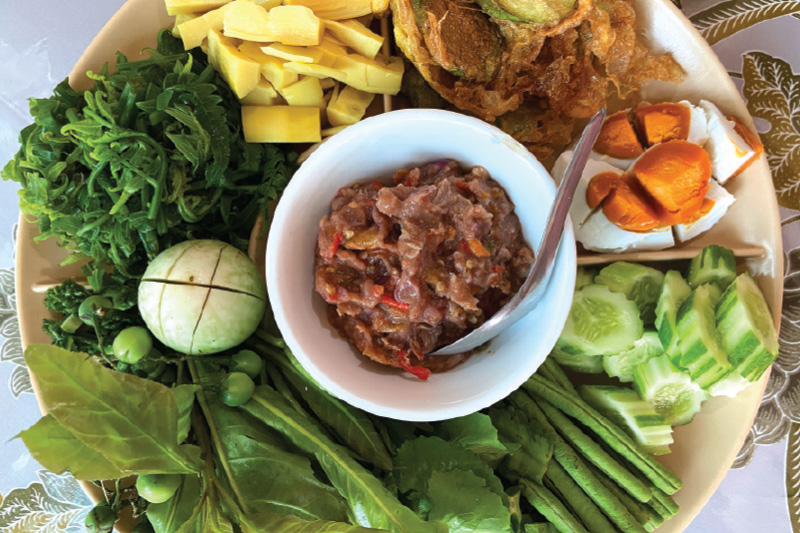
หนึ่งวันกับการลองลิ้มชิมรสในแดนใต้
มื้อเช้า
- ขนมจีนที่มีน้ำยาหลากหลายพร้อมเครื่องเคียง อย่าลืมไก่ทอดและห่อหมก
- ลองไปสำรวจตลาดเพื่อดูตัวเลือกอื่นๆ สำหรับมื้อเช้า ถ้าอยู่ที่ภูเก็ตลองชิม “ขนมสด” และปาท่องโก๋จิ้มสังขยามะพร้าว หรือถ้าอยากจัดเต็ม ลองโรตีทอดหรือมะตะบะดู
- ติ่มซำเป็นตัวเลือกอาหารเช้ายอดนิยมในภูเก็ต ตรัง และอำเภอหาดใหญ่
มื้อกลางวัน
- ที่สมุย ลองชิมยำหอยเม่นและหอยเจาะ อาหารท้องถิ่นยอดนิยมอีกอย่างคือ “หมึกสาย” หรือ “วายต้มกะทิ” ที่ทำจากหมึกสายต้มในกะทิ อาหารที่ต้องลองชิมอีกจานคือ “หมูคั่วเคย” ที่ได้จากการคั่วหมูสามชั้นกับกะปิและสมุนไพรท้องถิ่น
- เมื่อถึงถิ่นภูเก็ต ต้องลองกินอาหารเปอรานากัน ตัวเลือกยอดนิยม เช่น “หมูฮ้อง” (หมูตุ๋น) และ “แกงตูมี้” หรือแกงเผ็ดปลากับกระเจี๊ยบ หรือจะลองหมี่ฮกเกี้ยนกับ “โลบะ” หรือส่วนต่างๆ ของหมูต้มพะโล้แล้วนำไปทอดกับปอเปี๊ยะแบบท้องถิ่น
มื้อเย็น
- ไม่ว่าจะเป็นหาดไหนของประเทศไทย แน่นอนว่าผู้มาเยือนจะได้พบกับแหล่งรวมอาหารทะเลที่ยิ่งสดยิ่งดี ที่จังหวัดชุมพร ชาวประมงพื้นบ้านเปิดแผงขายปลาหมึกย่างที่สดที่สุดที่ฉันเคยชิมมา และถ้ามาภูเก็ตก็ต้องลองมาชิมอาหารทะเลที่ปรุงกันสดๆ ได้ที่ร้านอาหารพื้นบ้านริมหาดราไวย์ได้เลย
